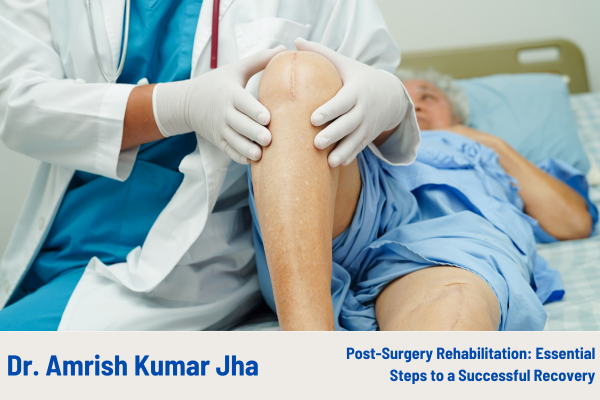Post-Surgery Rehabilitation: Essential Steps to a Successful Recovery
Surgery is often just the first step in resolving an orthopedic issue. The recovery process, which includes post-surgery rehabilitation, plays a crucial role in the overall success of the procedure. Dr. Amrish Kumar Jha, one of the best orthopedic surgeons in North Kolkata, emphasizes the importance of rehabilitation to regain strength, mobility, and functionality. This blog outlines key steps to ensure a smooth recovery after surgery.
Dr. Amrish Kumar Jha
10/1/20243 min read


Post-Surgery Rehabilitation: Essential Steps to a Successful Recovery
Surgery is often just the first step in resolving an orthopedic issue. The recovery process, which includes post-surgery rehabilitation, plays a crucial role in the overall success of the procedure. Dr. Amrish Kumar Jha, one of the best orthopedic surgeons in North Kolkata, emphasizes the importance of rehabilitation to regain strength, mobility, and functionality. This blog outlines key steps to ensure a smooth recovery after surgery.
Why Post-Surgery Rehabilitation is Important
Post-surgery rehabilitation focuses on restoring the body’s normal function after an operation. Whether it’s joint replacement, fracture repair, or soft tissue surgery, rehabilitation is crucial for:
Reducing Pain and Swelling: Exercises and therapies help manage post-operative discomfort and reduce swelling.
Restoring Mobility and Flexibility: Physical therapy improves movement and flexibility in the affected area, reducing stiffness.
Strengthening Muscles: Strength training helps rebuild the muscles around the surgical site, preventing weakness and further injury.
Preventing Complications: Early movement and exercise can prevent complications such as blood clots or muscle atrophy.
Speeding Up Recovery: A structured rehabilitation program accelerates the healing process, allowing patients to return to daily activities sooner.
Key Steps for Post-Surgery Rehabilitation
Follow Your Doctor’s Instructions
After surgery, your orthopedic surgeon will provide specific guidelines for recovery. This may include advice on managing pain, restrictions on movement, and how to care for the surgical site. Following these instructions diligently is the first step to a smooth recovery.
Start Physical Therapy Early
Early rehabilitation is vital for regaining mobility and strength. Depending on the type of surgery, your doctor may recommend starting physical therapy within days of the operation. A physical therapist will guide you through exercises that focus on:
Range of Motion: Gentle exercises to improve joint flexibility and reduce stiffness.
Strength Training: Exercises to rebuild muscles that may have weakened due to surgery or immobility.
Balance and Coordination: To improve stability and prevent falls.
Manage Pain Effectively
Pain management is an important part of post-surgery recovery. Your doctor may prescribe medications or recommend over-the-counter pain relievers. It’s essential to communicate with your healthcare provider about your pain levels to ensure proper management. Avoid overuse of pain medications, as they can have side effects or lead to dependency.
Gradual Increase in Activity
Rest is essential after surgery, but it’s equally important to gradually increase your activity level to regain strength and endurance. Avoid pushing yourself too hard, as this can lead to setbacks. Follow your physical therapist’s instructions for progressing with exercises and movements.
Eat a Balanced Diet
Nutrition plays a significant role in healing. A well-balanced diet rich in proteins, vitamins, and minerals helps speed up the recovery process. Focus on foods that promote tissue repair and reduce inflammation, such as lean meats, fruits, vegetables, and whole grains. Staying hydrated is equally important to support healing.
Monitor for Complications
While most patients recover smoothly, it’s important to watch for signs of complications, such as infection, excessive swelling, or severe pain. Contact your doctor if you experience:
Redness or pus around the surgical site
Fever
Increased pain that doesn’t improve with medication
Trouble moving the affected limb
Early intervention can prevent complications from worsening.
The Role of Patience in Recovery
It’s essential to remember that recovery takes time. Every patient’s healing process is different, and pushing too hard too soon can lead to setbacks. Patience and consistent adherence to your rehabilitation plan are key to a successful recovery.
Conclusion
Post-surgery rehabilitation is an integral part of the healing process, ensuring that patients regain strength, mobility, and functionality. Dr. Amrish Kumar Jha, one of the best orthopedic surgeons in North Kolkata, stresses that following a structured rehabilitation program is critical for a smooth recovery. By taking the right steps and working closely with healthcare professionals, you can ensure a successful outcome after surgery.
